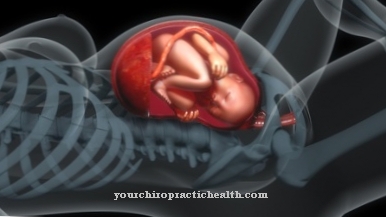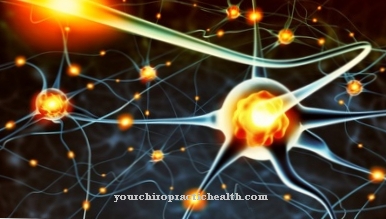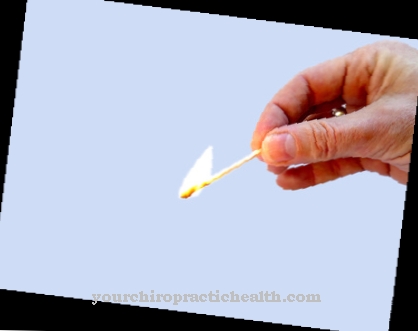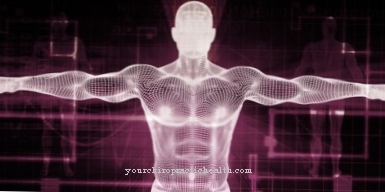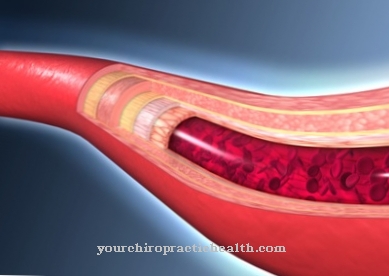At the central venous pressure it is the blood pressure in the superior vena cava and in the right atrium of the heart. It is used in medicine as an indicator of blood volume. If the venous pressure is too high or too low, this may a. indicate various heart and lung diseases.
What is central venous pressure?

Medicine understands the central venous pressure to be the blood pressure that prevails in the superior vena cava. The so-called superior vena cava is located in the chest cavity and in it the blood from the arms, neck and head flow together. The place where the blood vessels join is called the venous angle or angulus venosus. There is a vein angle on each side of the body.
Doctors measure the central venous pressure using a venous catheter. The patient lies still during the measurement. The examiner inserts a thin plastic tube into the vein. The catheter penetrates the vein below the right collarbone and goes through the vein to the heart area. This measurement enables very precise results. Doctors can also use the catheter to administer medication. In this way, the body can make optimal use of electrolyte solutions and heart medication.
Function & task
In the past, doctors used the central venous pressure as a measure to estimate the total blood and fluid volume of the organism. However, this procedure is largely considered out of date. Instead, modern medicine uses venous pressure to predict the preload. Preload is the force that causes the muscle fibers in the heart's ventricles to stretch. The preload occurs at the end of a diastole, i. H. at the end of the relaxation phase of the heart muscle.
Central venous pressure depends on both blood volume and vascular tone. The vascular tone influences the blood pressure and describes the total peripheral resistance in the blood vessels. Mainly hormones and the movements of the muscles, which are located on the outside of the blood vessels, affect the vascular tone.
In addition to these two factors, the pressure in the right atrium of the heart also plays a major role in central venous pressure. On the other hand, the pressure that acts mechanically on the veins in the chest (intrathoracic pressure) influences the central venous pressure.
In a healthy person, the central venous pressure should be between 0 and 9 mmHg. When measuring using a column of liquid, the liquid rises by up to 12 cm. The displayed value is the arithmetic mean of the central venous pressure. In addition, diagnosticians can also display the course of venous pressure over time in the form of a curve. The venous pressure follows certain phases that are repeated cyclically. They depend on the heartbeat: when the heart muscle contracts, the heart pumps blood from its chambers into the venous system.
More body juice flows in from the arteries. These transport the oxygen-rich blood to the heart after the red blood cells have bound it in the lungs.
The cycle of venous pressure itself has different phases. First of all, the A-wave appears, which indicates the contraction of the atrium of the heart. This is followed by the C wave - during this time, a heart valve closes the atrium and bulges in the process. The subsequent X-depression means that the atrium relaxes as the contraction of the smooth heart muscles subsides. During the V-wave, blood then flows into the right atrium of the heart. Finally, the curve of the central venous pressure shows the Y depression, during which the body releases the blood from the heart and pumps it into the vein with pressure. The cycle then repeats itself with the next heartbeat.
Illnesses & ailments
Deviations in central venous pressure can indicate various diseases and syndromes. For example, the lack of volume leads to a conspicuous finding when measuring the central venous pressure. Medicine describes a condition in which there is too little blood in the circulation as volume deficiency or hypovolemia. A lack of volume can indicate a loss of blood, even if the bleeding is not caused by external injuries. The central venous pressure is therefore also an indirect indicator of the presence of internal bleeding.
Medicine distinguishes between absolute and relative volume deficiency. In the case of absolute volume deficiency, blood loss is the cause of the syndrome; In the case of a relative lack of volume, on the other hand, weaknesses in the cardiovascular system mean that the blood is incorrectly distributed in the organism and thus cannot adequately supply all parts of the body.
In addition to the lack of volume, a noticeable central venous pressure can also indicate a certain weakening of the heart muscle, the so-called right heart failure. Since doctors measure the central venous pressure in the vein in front of the right atrium, it is particularly sensitive to changes in the heart's activity on the right side.Right heart failure can be caused by various underlying diseases and congenital or acquired malformations.
Furthermore, disturbances of the water-electrolyte balance manifest themselves potentially in the central venous pressure: The relationship between fluid and electrolytes is disturbed. The cause of such an imbalance is, for example, overhydration, which is also known as hyperhydration. The water content of the human body rises above normal - either through abnormal fluid intake or through disorders of the heart or kidneys. Hormonal diseases can also cause hyperhydration.

